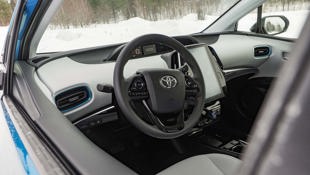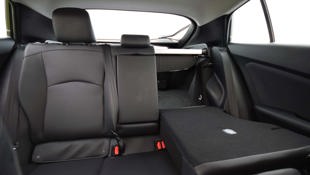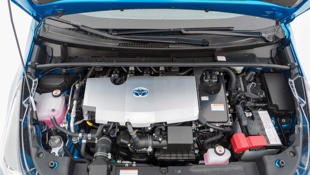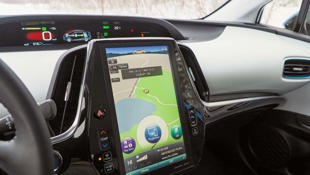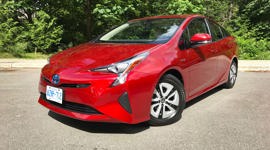 AutoTrader SCORE
AutoTrader SCORE
-
STYLING7/10
-
Safety9/10
-
PRACTICALITY8/10
-
USER-FRIENDLINESS7/10
-
FEATURES8/10
-
POWER6/10
-
COMFORT8/10
-
DRIVING FEEL8/10
-
FUEL ECONOMY9/10
-
VALUE8/10
Northerners waiting for an affordable, all-wheel-drive hybrid just got another option to consider thanks to the 2020 Toyota Prius AWD-e. That’s right: An all-wheel-drive-equipped Prius is now a thing that exists, a move that’s likely to put more Priuses in northern driveways.
Current Prius owners looking to upgrade get exactly what they expect – driving manners and fuel consumption consistent with Prius models past and present, with extra traction dialled in where it’s needed most.
My time with the Prius AWD-e included plenty of use during a heavy winter storm in my hometown of Sudbury, Ont., proving the perfect test of what this latest version has to offer.
Styling: 7/10
The Toyota Prius has style, for better or for worse. Some people like its uniqueness; others think it looks weird. Few people buy a Prius because of how it looks, though it is immediately recognizable in traffic, and some owners dig that.
The electric blue paint applied to my tester looks fantastic in person and prompted me to keep clicking away on my camera as the winter storm worsened.
In summary, the Prius’ styling is fine. If you don’t get too excited by it, you’re a completely normal human being.
Safety: 9/10
It’s pretty much all here: Adaptive cruise control, lane-departure alert, blind-spot monitoring, a rear-view camera, and more. Toyota takes safety seriously, making most safety features standard on all its vehicles. Accordingly, Prius is equipped with features like pedestrian detection, steering assist, and automatic high-beams. This comes as part of Toyota’s Safety Sense system.
Further, the Prius has excellent headlights. With spectacular white lighting, fantastic reach, and steering-responsiveness, the after-dark lighting performance rivals twice-the-price luxury cars all day [er, night – Ed.] long.
Practicality: 8/10
It’s not a cargo van or anything, but the Prius’s cargo hold is pretty slick. Its liftback hatch opens wide, the load-in height is relatively low, and a mid-size pooch should have no issues jumping in and out. A handy mesh accessory net keeps gear secure on rougher roads, and a proper handle to close the hatch eliminates the need to touch wintertime road-filth once the back is loaded – although it does require a bit of muscle to lift. The rear seats also fold down lickety-split for ladders, skis, and the like.
On board, four adults of roughly average height will find sufficient room in most directions, with headroom running out first for taller rear-seat occupants. At 5-foot-10, I could sit behind myself comfortably, with more than ample legroom.
User Friendliness: 7/10
The Toyota Prius is super easy to drive, and shouldn’t cause much stress to operate. It starts with the press of a button, shifts gears with a flick of an index finger on the stubby joystick-like shifter, and the steering is so light during parking that it feels almost toy-like.
The tall windshield enables a good outward view that’s largely free of visual clutter since the Prius keeps its instrumentation on the centre of its dash, not in front of the driver.
With a few flicks on the steering-wheel-mounted track pads, drivers can call up various displays to monitor the AWD system, safety features, fuel economy, hybrid driveline, and more.
By the way, that steering wheel is generously heated with the press of a button. On a cold morning, it’s better than the thickest gloves found in the closet. That’s a good thing, because the central touchscreen only accepts inputs from bare fingertips.
It’s a tall and thin screen, and is oriented like a smartphone. For the money, shoppers after the most vivid and high-resolution graphics do have better options, though the system is logical and straightforward after a bit of practice. There are embedded touch-sensitive buttons near the screen for volume, climate control settings, and more, though they don’t work with gloves on either.
Apple CarPlay is on board, though Android Auto is not yet part of the package.
Features: 8/10
My tester felt well-equipped, relative to the innovative and pricey driveline built into its $35,000 sticker, which includes the Technology package.
My favourite features include the headlights, the heated steering wheel, and the on-screen hybrid drive display. The latter comes complete with driver-selectable configurations for excellent visualization of the hybrid system’s real-time operation. The drive computer can show an all-wheel drive power output meter, too. Clever touches like these help deliver a more engaging drive that leaves users feeling more connected with the technology they’ve just invested in.
Further, the adaptive cruise control is smooth, predictable, and trustworthy on the highway.
Power: 6/10
This is Canada’s most fuel-efficient all-wheel-drive hybrid, and it does its best work when driven gently, and not in a particular rush. Not only is this sort of driving the quietest and most fuel-efficient, but it also makes the Prius feel almost like a luxury car thanks to smooth and quiet acceleration, and a laid-back and comfortable drive.
The Prius hustles along just fine if called upon. It even has a Power mode that turns up the performance and throttle response. Here, it can boot along spiritedly in city driving, albeit with a good bit of sound coming in from the engine compartment.
This is not a car for doing skids or passing 18-wheelers quickly. If you get the engine working enough to hear it, the sound isn’t particularly lovely, either. Light-footed drivers primarily concerned with good fuel economy will find it pretty much perfect.
Comfort: 8/10
The Prius features a nicely done ride. If you’re test-driving other smaller cars and find them too sporty and stiff, you’ll probably like what’s going on here. The suspension feels dense and substantial beneath you, not flimsy or delicate. Even when the suspension is taking a beating on rougher roads, it still manages to convey a dense softness around the outer edges of the suspension’s travel. Translation? Even on nasty roads, the Prius rarely feels like it’s crashing into bumps and craters.
The synthetic leather seats are ultra slippery, which makes sliding in and out of them hilariously easy when you’re wearing your snowsuit.
Further, when out on wintery highways, the Prius gave me some of my favourite things for driving comfort: A great outward view, a great lighting system, and easy-to-memorize, logical positioning of the steering-wheel-mounted controls.
The climate control system does a good job of keeping all occupants toasty warm – once it’s up to temperature. At -15 degrees Celsius, the cabin warms at about the same rate as a conventional car, though perhaps a moment more slowly. The heated seats and steering wheel are welcome touches on the coldest mornings, until the heater is up to speed after a minute or two of driving.
Driving Feel: 8/10
The concept of the Prius’s new AWD-e system is fairly simple: Up front, it’s a gas engine and battery-fed electric motor propelling the front wheels, the same as any other Prius. The AWD-e system adds a second battery-fed electric motor in the rear to drive the rear wheels as well.
As soon as the throttle is depressed, all four wheels receive power, with gas-hybrid output going to the front wheels, and supplemental electric power heading to the rear. Essentially, the operation is like that of any other all-wheel drive system, even though the Prius uses different hardware to get the job done.
The rear motor powers the rear wheels at virtually all times that you’re going less than 10 km/h. When taking off from a stop-light or pulling out from a parking lot into a busy side-street covered in more than a few centimetres of slush, the car moves with immediacy.
Once moving, the rear wheels do less work, though they can still be powered electrically and immediately on an as-needed basis, up to about 65 km/h. By the way, most modern all-wheel drive systems stop sending power to the rear wheels once up to speed and cruising, too.
So, with a simple electric motor, the Prius gains a bump in traction where it’s needed most in wintery driving. Leaving most forms of front-wheel-drive vehicle in the dust between traffic lights in boot-deep snow never gets old. It’s certainly not a snow-flinging, power-sliding, all-wheel-drive monster, though several good ones are available for similar money. What AWD-e is, however, is a means of making this the first Prius ever that gets off the line in a jiff – and in deep snow.
From the driver’s seat, it does exactly what the all-wheel-drive user expects, providing point-and-shoot traction with nothing required of them.
Elsewhere, the steering and brakes are both lacking any meaningful feel, though both perform well in greasy driving.
The steering firms up at higher speeds, making it easy to give the car the gentle inputs that are vital to maximum control in winter driving. The brakes feel like they’re fully capitalizing on the extra bite from the winter tires, and even split-traction stopping tests saw minimal tendency for the car to try and rotate. Put another way, most drivers will find the Prius to feel nicely behaved in inclement winter weather, even if evasive manoeuvres are required.
With 120 hp, the Prius won’t get much attention from the enthusiasts out there, though the nicely composed suspension and fairly quick steering do give it some surprisingly good reflexes on winding roads.
Fuel Economy: 9/10
The Toyota Prius is excellent on fuel, coming in as one of Canada’s most fuel-efficient cars, even when equipped with all-wheel drive. As a hybrid, it uses a gas-powered engine, electric motors, and recharging batteries. By combining electricity and gas power, drivers get a big bite out of their fuel bill and emissions.
The fuel economy of the Prius AWD-e is similar to that of a much smaller and less powerful car without all-wheel drive.
Value: 8/10
Light-footed shoppers concerned primarily with tiny fuel bills, all-wheel drive capability, and plenty of safety gear should strongly consider taking the Prius AWD-e for a test drive – though it’s not the sportiest, largest, or most luxurious vehicle available at this price-point.
The Verdict
For the way most folks will use a car like this most of the time, the new AWD-e system works well to make this car the most winter-ready Prius yet – and one that’ll keep you moving confidently, even in challenging conditions.
| Engine Displacement | 1.8L |
|---|---|
| Engine Cylinders | I4 hybrid |
| Peak Horsepower | 120 hp |
| Peak Torque | n/a |
| Fuel Economy | 4.5/4.9/4.7 L/100 km cty/hwy/cmb |
| Cargo Space | 697 / 1,558 L seats down |
| Model Tested | 2020 Toyota Prius Technology AWD-e |
| Base Price | $35,250 |
| A/C Tax | $100 |
| Destination Fee | $1,770 |
| Price as Tested | $37,120 |
|
Optional Equipment
None
|
|















